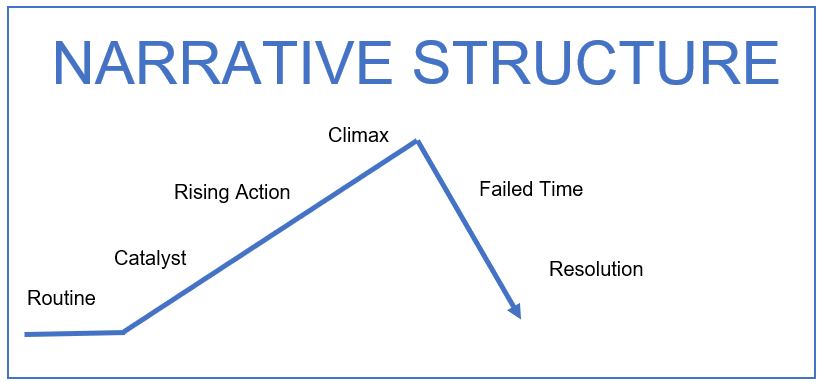Story or narrative structure is the specific order in which events are organised. Even if the frame can be different, almost every story has the same elements: the routine life, the catalyst, the rising action, the climax, the failed time and the resolution.

Various structures exist, but we present some of the most common ones.
Dan Harmon’s Story Circle
The “Story Embryo”, or Dan Harmon’s Story Circle, is an eight-step structure where the protagonist pursues a goal outside his everyday world. The steps are the comfort zone; the protagonist has some needs; he enters an unfamiliar situation; adapts to it; he reaches what he wants; he loses a lot for it; he returns to his comfort zone and is changed.
Fichtean Curve
In this simple narrative structure, there are only three elements: the rising action, the climax and the falling action. The rising actions happen a few times during the stories. They drive the hero through the story with more tension added every time until he reaches the climax. This one should show how your character reacts to that final crisis. After all those actions and the climax, the falling action appears. It is when you release all tensions and can explain and solve all the situations that happened until now.
Freytag’s Pyramid
This one is the tragic one. It comprises the following elements: Introduction, Rise, Climax, Return/Fall and Catastrophe. This structure is less used nowadays as people prefer happy endings over sad stories.
Linear Plot Structure
The idea of this structure is to tell the events in the order they occur, in chronological order. The hero can still return to the past in a flashback, but it must be clearly mentioned. This narrative structure is the most used one in various forms of storytelling.
Nonlinear Plot Structure
Unlike the previous one, this structure does not respect the chronological order at all! You take the risk of losing your audience through the story, but it also creates an intense dynamic around your narrative and asks for more concentration from them.
Parallel Plot Structure
The name says it all: different stories happening simultaneously without apparent connection. They sometimes finally cross each other’s paths, but it is not a must.
Three-Act Structure
As the name says, it is a structure split into three acts: the set-up, the confrontation and the resolution. In the setup, you will find the exposition (the foundation of your story), the inciting incident (life change for your protagonist), and the first turning point (after challenges, the hero takes his new path). Then, in the confrontation, there is the rising action (new characters, new challenges, new world), the midpoint (an event that creates a real before/after) and the second turning point (another twist which makes the protagonist look as if he failed). And finally, the third act, the resolution. It is made up of the false climax (the character realises he needs to take decisive action to win), the climax (the final battle) and the denouement/resolution (back to a day-to-day life but with new habits/perspectives). This scheme can be helpful if you need concrete directions to structure your story.
